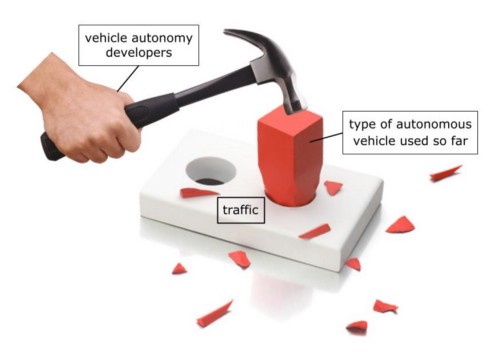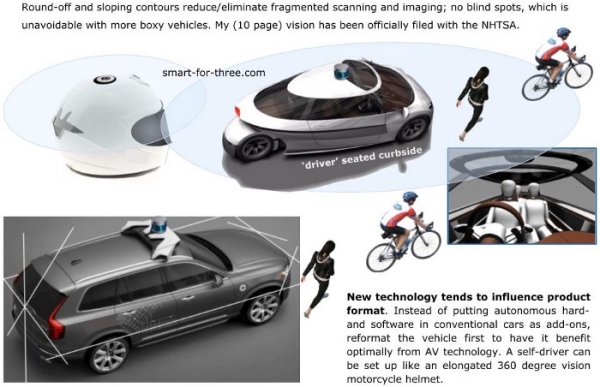Something meaningful about driverless, for a change
This is refreshing, really.
I have written a lot about the depressing hype and waste of effort around driverless cars. This time I am happy to point readers to something that is actually interesting, and productive. It is an argument I just read, about the “Twilight Zone self-driving development can’t seem to get out of” (but also applies to electric vehicles). Here’s the argument:

- If people have already wasted billions trying to make self-driving work, it is also because they overlooked the obvious fact that vehicle size, footprint and shape matter a lot
- (successful) New technology tends to reformat products
- This is exactly what happened with personal communication. It succeeded also because it went from “bulky, cumbersome and fixed [devices…] to sleek smartphones”
- Personal mobility should do the same, that is optimize for driverless movement, where it is actually possible of course, the very shape of cars
- Driverless, that is, cannot “become real [without] deploying sleek-footprint vehicles”
- (instead) there still is a “huge void between the car that has grown obese (SUV trend) and micro-mobility”
Less corners = more chances to go driverless, some day
Quoting from this picture (see the article for bigger version and links):

- Round-off and sloping contours reduce/eliminate fragmented scanning and imaging: no blind spots, which is unavoidable with more boxy vehicles
- Instead of putting autonomous tech in conventional cars, as add-ons, reformat the vehicle first
THIS is what I find refreshing. Driverless versions of today’s “private cars for the masses” remain a pipe dream, of course. But shared driverless cars, which may do a lot of good, could become real only if done from scratch, not by retrofitting old stuff, and old business models.
Who writes this, why, and how to help
I am Marco Fioretti, tech writer and aspiring polymath doing human-digital research and popularization.
I do it because YOUR civil rights and the quality of YOUR life depend every year more on how software is used AROUND you.
To this end, I have already shared more than a million words on this blog, without any paywall or user tracking, and am sharing the next million through a newsletter, also without any paywall.
The more direct support I get, the more I can continue to inform for free parents, teachers, decision makers, and everybody else who should know more stuff like this. You can support me with paid subscriptions to my newsletter, donations via PayPal (mfioretti@nexaima.net) or LiberaPay, or in any of the other ways listed here.THANKS for your support!